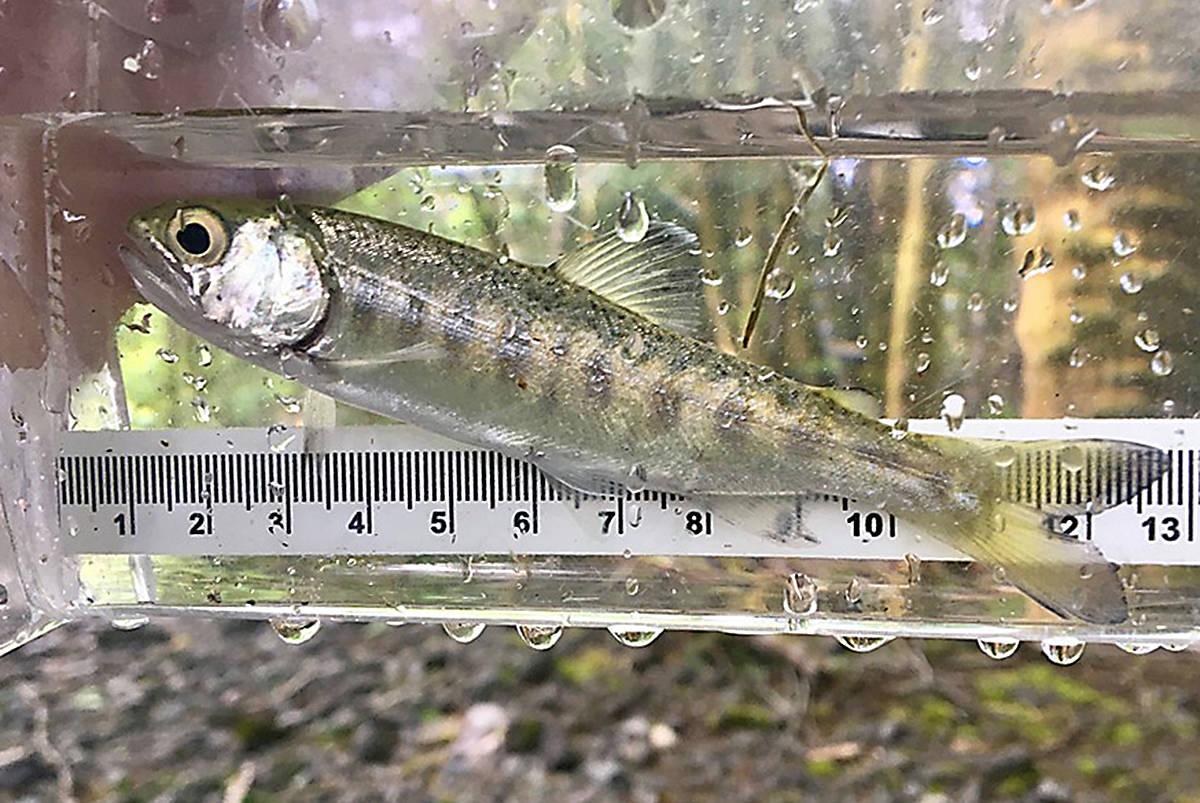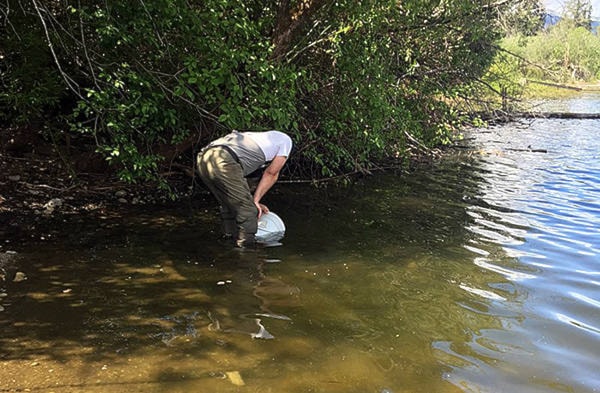It’s early in the year but already salmon fry are being left high and dry at Cowichan Lake on Vancouver Island, which is already at mid-July low water levels.
Members of the Cowichan Lake and River Stewardship Society posted the alert on Facebook Tuesday, May 21.
“Fry rescue operations began in earnest today as crews visited several tributaries to Cowichan Lake. Some of our worst fears were confirmed,” the note said. “Meade Creek and any remaining pools are barren. This is one of the most productive tributaries and we regularly see thousands of coho and chum fry there.”
Ken Traynor, president of the Cowichan Lake and River Stewardship Society, agreed later that same day that the situation is worrying. However, some fish in the Cowichan River have managed to escape the worst of it.
“My understanding, based on reports from different folk, is that in the upper river around Lake Cowichan itself, which are the major spawning beds for the chinook salmon, the fry there appear to have done quite well. What I’m thinking is that the river was high enough early on in February. It never got below 25 cubic metres per second. When you get lower in the river —the mid-river, down around the park and Riverbottom Road— where you have a lot more of the chum in the river, the spawning beds in that part of the river appear to have been more exposed in that really dry patch that we had in March.”
That unusual weather was of considerable importance, he said.
“The lowest level of the lake this year was about March 15. It was about 28 per cent of capacity. It’s never been that low, according to the records that I’ve seen. We had a really dry January-February and into March and that really exposed the beds in the middle river is my understanding. That’s where the worst of the problem in the river seems to be.”
Meanwhile, up around Cowichan Lake itself, the Stewardship Society’s volunteers have been finding trouble.
“Nixon Creek was checked last week, and was dry and pools there were similarly barren. The winter drought has taken a huge toll in these tributaries. Ashburnham Creek is likewise dry and only 30 coho fry were rescued there, mostly yearlings. Sutton Creek is flowing [however] and appears to be supporting coho fry. Lower Robertson River yielded about 600 coho fry that were transported to Bear Lake,” the report released on Facebook said.
Traynor said he knows about those problems, but there’s more than just weather at fault.
Using Nixon Creek as an example, he said, “there, what you’ve got is an awful lot of gravel down at the mouth so it complicates the flow. Even though there may still be some water up in the pools, the access out to the lake appears to be pretty challenging.
“The Robertson River is still flowing but it’s low and I know that Joy Wade, who does an awful lot of the work around the Cowichan lamprey, is that she’s not going to do any further research this year because she just finds the water’s too low and she’s worried she’ll be stressing out the lamprey. Their most extensive spawning bed seems to be at the bottom of the Robertson River at Bear Lake.
“We’ve had a really dry spring, which has created some problems. I took a look yesterday and we’re at July 19th levels out on the lake.
“And of course this is the key period for the fry: both for those that hatched in the river and are moving up to the lake,” Traynor said. “Then, there are some of the chinook that have been up in the lake for the last year are now making their way down to the ocean. This is a key period to have water in the river.”
But when and how to manage the river’s flow is a difficult challenge.
“Now the tension is: in order to make sure we’ve got a salmon population in this year, we need to maintain the levels but if we maintain the river flow levels at this point we may end up with next to nothing in the lake come August. Trying to get it right as to how you allocate what little water we’ve got behind the weir right now is tough.”
Traynor said he and others are anxiously watching “a fairly detailed conversation going on right now among Catalyst, the Department of Fisheries, Cowichan Tribes, the Cowichan Watershed Board, and people like Joe Saysell and Parker Jefferson and others in the angling community. They’ve all been having these discussions about how best to manage water levels.
“The Cowichan Watershed Board meets next Monday, and it will be interesting to get a report from them.”
There are definitely some important decisions ahead this year, according to Traynor.
“The fry rescue is one thing. Sandy Cummings, Parker Jefferson, Joe Saysell and others are collaborating well with people from Cowichan Tribes and Lake Cowichan First Nation. They’ve got quite a team of people that go out. I know Joe Saysell is out pretty well every day on the river in his boat; he drifts it. Last year, I think they talked of having moved about 100,000 fry. That’s pretty regular now. Four of the last five years have been essentially droughts. That’s a pretty common number to have to move out of the creeks.”
One positive thing that’s come out of the problems of the past few years is that all the talk about changes to be made to the weir at Lake Cowichan is now reaching the stage where engineering studies are being organized. Actual construction may be a long way off, but at least steps are being taken, according to Traynor.

